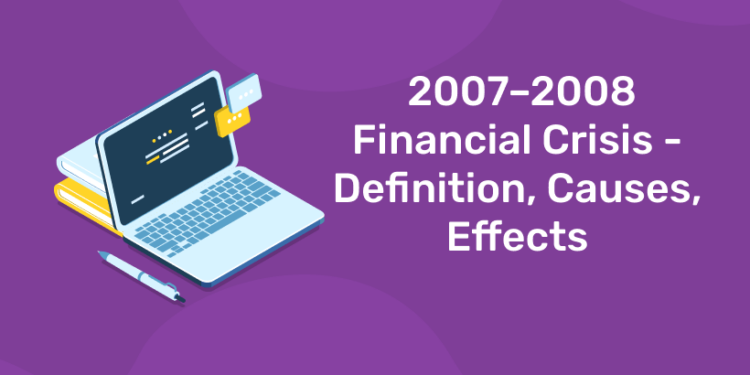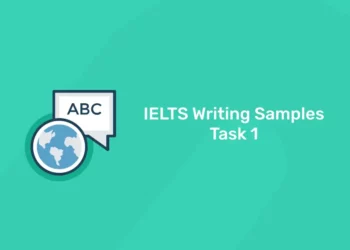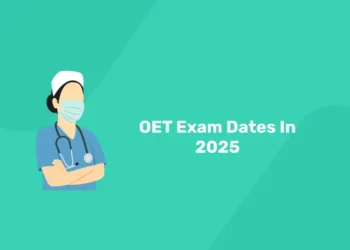Table of Contents
Definition of Financial Crisis
Financial crisis of 2007–08, also called subprime mortgage crisis, had a severe contraction of liquidity in global financial markets that originated in the United States as a result of the collapse of the U.S. housing market. It threatened to destroy the international financial system, caused the failure (or near-failure) of several major investment and commercial banks, mortgage lenders, insurance companies, and savings and loan associations, and precipitated the Great Recession (2007–09), the worst economic downturn since the Great Depression (1929–c. 1939).
Although the exact causes of the financial crisis are a matter of dispute among economists, there is general agreement regarding the factors that played a role (experts disagree about their relative importance).
First, the Federal Reserve (Fed), the central bank of the United States, having anticipated a mild recession that began in 2001, reduced the federal funds rate (the interest rate that banks charge each other for overnight loans of federal funds—i.e., balances held at a Federal Reserve bank) 11 times between May 2000 and December 2001, from 6.5 percent to 1.75 percent. That significant decrease enabled banks to extend consumer credit at a lower prime rate (the interest rate that banks charge to their “prime,” or low-risk, customers, generally three percentage points above the federal funds rate) and encouraged them to lend even to “subprime,” or high-risk, customers, though at higher interest rates (see subprime lending). Consumers took advantage of the cheap credit to purchase durable goods such as appliances, automobiles, and especially houses. The result was the creation in the late 1990s of a “housing bubble” (a rapid increase in home prices to levels well beyond their fundamental, or intrinsic, value, driven by excessive speculation).
Second, owing to changes in banking laws beginning in the 1980s, banks were able to offer to subprime customers mortgage loans that were structured with balloon payments (unusually large payments that are due at or near the end of a loan period) or adjustable interest rates (rates that remain fixed at relatively low levels for an initial period and float, generally with the federal funds rate, thereafter). As long as home prices continued to increase, subprime borrowers could protect themselves against high mortgage payments by refinancing, borrowing against the increased value of their homes, or selling their homes at a profit and paying off their mortgages. In the case of default, banks could repossess the property and sell it for more than the amount of the original loan. Subprime lending thus represented a lucrative investment for many banks. Accordingly, many banks aggressively marketed subprime loans to customers with poor credit or few assets, knowing that those borrowers could not afford to repay the loans and often misleading them about the risks involved. As a result, the share of subprime mortgages among all home loans increased from about 2.5 percent to nearly 15 percent per year from the late 1990s to 2004–07.
Third, contributing to the growth of subprime lending was the widespread practice of securitization, whereby banks bundled together hundreds or even thousands of subprime mortgages and other, less-risky forms of consumer debt and sold them (or pieces of them) in capital markets as securities (bonds) to other banks and investors, including hedge funds and pension funds. Bonds consisting primarily of mortgages became known as mortgage-backed securities, or MBSs, which entitled their purchasers to a share of the interest and principal payments on the underlying loans. Selling subprime mortgages as MBSs was considered a good way for banks to increase their liquidity and reduce their exposure to risky loans, while purchasing MBSs was viewed as a good way for banks and investors to diversify their portfolios and earn money. As home prices continued their meteoric rise through the early 2000s, MBSs became widely popular, and their prices in capital markets increased accordingly.
Fourth, in 1999 the Depression-era Glass-Steagall Act (1933) was partially repealed, allowing banks, securities firms, and insurance companies to enter each other’s markets and to merge, resulting in the formation of banks that were “too big to fail” (i.e., so big that their failure would threaten to undermine the entire financial system). In addition, in 2004 the Securities and Exchange Commission (SEC) weakened the net-capital requirement (the ratio of capital, or assets, to debt, or liabilities, that banks are required to maintain as a safeguard against insolvency), which encouraged banks to invest even more money into MBSs. Although the SEC’s decision resulted in enormous profits for banks, it also exposed their portfolios to significant risk, because the asset value of MBSs was implicitly premised on the continuation of the housing bubble.
Fifth, and finally, the long period of global economic stability and growth that immediately preceded the crisis, beginning in the mid- to late 1980s and since known as the “Great Moderation,” had convinced many U.S. banking executives, government officials, and economists that extreme economic volatility was a thing of the past. That confident attitude—together with an ideological climate emphasizing deregulation and the ability of financial firms to police themselves—led almost all of them to ignore or discount clear signs of an impending crisis and, in the case of bankers, to continue reckless lending, borrowing, and securitization practices.
Master stock trading with us. Enroll now for a free demo!
Key events of the crisis
1: What is a stock?
Beginning in 2004 a series of developments portended the coming crisis, though very few economists anticipated its vast scale. Over a two-year period (June 2004 to June 2006) the Fed raised the federal funds rate from 1.25 to 5.25 percent, inevitably resulting in more defaults from subprime borrowers holding adjustable-rate mortgages (ARMs). Partly because of the rate increase, but also because the housing market had reached a saturation point, home sales, and thus home prices, began to fall in 2005. Many subprime mortgage holders were unable to rescue themselves by borrowing, refinancing, or selling their homes, because there were fewer buyers and because many mortgage holders now owed more on their loans than their homes were worth (they were “underwater”)—an increasingly common phenomenon as the crisis developed.
By 2007 the steep decline in the value of MBSs had caused major losses at many banks, hedge funds, and mortgage lenders and forced even some large and prominent firms to liquidate hedge funds that were invested in MBSs, to appeal to the government for loans, to seek mergers with healthier companies, or to declare bankruptcy. Even firms that were not immediately threatened sustained losses in the billions of dollars, as the MBSs in which they had invested so heavily were now downgraded by credit-rating agencies, becoming “toxic” (essentially worthless) assets. (Such agencies were later accused of a severe conflict of interest, because their services were paid for by the same banks whose debt securities they rated. That financial relationship initially created an incentive for agencies to assign deceptively high ratings to some MBSs, according to critics.) In April 2007 New Century Financial Corp., one of the largest subprime lenders, filed for bankruptcy, and soon afterward many other subprime lenders ceased operations. Because they could no longer fund subprime loans through the sale of MBSs, banks stopped lending to subprime customers, causing home sales and home prices to decline further, which discouraged home buying even among consumers with prime credit ratings, further depressing sales and prices. In August, France’s largest bank, BNP Paribas, announced billions of dollars in losses, and another large U.S. firm, American Home Mortgage Investment Corp., declared bankruptcy.
The crisis in the United States deepened in January 2008 as Bank of America agreed to purchase Countrywide Financial, once the country’s leading mortgage lender, for $4 billion in stock, a fraction of the company’s former value. In March the prestigious Wall Street investment firm Bear Stearns, having exhausted its liquid assets, was purchased by JPMorgan Chase, which itself had sustained billions of dollars in losses. Fearing that Bear Stearns’s bankruptcy would threaten other major banks from which it had borrowed, the Fed facilitated the sale by assuming $30 billion of the firm’s high-risk assets. Meanwhile, the Fed initiated another round of reductions in the federal funds rate, from 4.25 percent in early January to only 2 percent in April (the rate was reduced again later in the year, to 1 percent by the end of October and to effectively 0 percent in December). Although the rate cuts and other interventions during the first half of the year had some stabilizing effect, they did not end the crisis; indeed, the worst was yet to come.
By the summer of 2008 Fannie Mae (the Federal National Mortgage Association) and Freddie Mac (the Federal Home Loan Mortgage Corporation), the federally chartered corporations that dominated the secondary mortgage market (the market for buying and selling mortgage loans) were in serious trouble. Both institutions had been established to provide liquidity to mortgage lenders by buying mortgage loans and either holding them or selling them—with a guarantee of principal and interest payments—to other banks and investors. Both were authorized to sell mortgage loans as MBSs. As the share of subprime mortgages among all home loans began to increase in the early 2000s (partly because of policy changes designed to boost home ownership among low-income and minority groups), the portfolios of Fannie Mae and Freddie Mac became more risky, as their liabilities would be huge should large numbers of mortgage holders default on their loans. Once MBSs created from subprime loans lost value and eventually became toxic, Fannie Mae and Freddie Mac suffered enormous losses and faced bankruptcy. To prevent their collapse, the U.S. Treasury Department nationalized both corporations in September, replacing their directors and pledging to cover their debts, which then amounted to some $1.6 trillion.
Later that month the 168-year-old investment bank Lehman Brothers, with $639 billion in assets, filed the largest bankruptcy in U.S. history. Its failure created lasting turmoil in financial markets worldwide, severely weakened the portfolios of the banks that had loaned it money, and fostered new distrust among banks, leading them to further reduce interbank lending. Although Lehman had tried to find partners or buyers and had hoped for government assistance to facilitate a deal, the Treasury Department refused to intervene, citing “moral hazard” (in this case, the risk that rescuing Lehman would encourage future reckless behaviour by other banks, which would assume that they could rely on government assistance as a last resort). Only one day later, however, the Fed agreed to loan American International Group (AIG), the country’s largest insurance company, $85 billion to cover losses related to its sale of credit default swaps (CDSs), a financial contract that protects holders of various debt instruments, including MBSs, in the event of default on the underlying loans.
By this time there was general agreement among economists and Treasury Department officials that a more forceful government response was necessary to prevent a complete breakdown of the financial system and lasting damage to the U.S. economy. In September the George W. Bush administration proposed legislation, the Emergency Economic Stabilization Act (EESA), which would establish a Troubled Asset Relief Program (TARP), under which the Secretary of the Treasury, Henry Paulson, would be authorized to purchase from U.S. banks up to $700 billion in MBSs and other “troubled assets.” After the legislation was initially rejected by the House of Representatives, a majority of whose members perceived it as an unfair bailout of Wall Street banks, it was amended and passed in the Senate. As the country’s financial system continued to deteriorate, several representatives changed their minds, and the House passed the legislation on October 3, 2008; President Bush signed it the same day.
It soon became apparent, however, that the government’s purchase of MBSs would not provide sufficient liquidity in time to avert the failure of several more banks. Paulson was therefore authorized to use up to $250 billion in TARP funds to purchase preferred stock in troubled financial institutions, making the federal government a part-owner of more than 200 banks by the end of the year. The Fed thereafter undertook a variety of extraordinary quantitative-easing (QE) measures, under several overlapping but differently named programs, which were designed to use money created by the Fed to inject liquidity into capital markets and thereby to stimulate economic growth. Similar interventions were undertaken by central banks in other countries. The Fed’s measures included the purchase of long-term U.S. Treasury bonds and MBSs for prime mortgage loans, loan facilities for holders of high-rated securities, and the purchase of MBSs and other debt held by Fannie Mae and Freddie Mac. By the time the QE programs were officially ended in 2014, the Fed had by such means pumped more than $4 trillion into the U.S. economy. Despite warnings from some economists that the creation of trillions of dollars of new money would lead to hyperinflation, the U.S. inflation rate remained below the Fed’s target rate of 2 percent through the end of 2014.
Enroll in our stock course!
Effects of the crisis
In 2012 the St. Louis Federal Reserve Bank estimated that during the financial crisis the net worth of American households had declined by about $17 trillion in inflation-adjusted terms, a loss of 26 percent. In a 2018 study, the Federal Reserve Bank of San Francisco found that, 10 years after the start of the financial crisis, the country’s gross domestic product was approximately 7 percent lower than it would have been had the crisis not occurred, representing a loss of $70,000 in lifetime income for every American. Approximately 7.5 million jobs were lost between 2007 and 2009, representing a doubling of the unemployment rate, which stood at nearly 10 percent in 2010. Although the economy slowly added jobs after the start of the recovery in 2009, reducing the unemployment rate to 3.9 percent in 2018, many of the added jobs were lower paying and less secure than the ones that had been lost.
For most Americans, recovery from the financial crisis and the Great Recession was exceedingly slow. Those who had suffered the most—the millions of families who lost their homes, businesses, or savings; the millions of workers who lost their jobs and faced long-term unemployment; the millions of people who fell into poverty—continued to struggle years after the worst of the turmoil had passed. Their situation contrasted markedly with that of the bankers who had helped to create the crisis. Some of those executives lost their jobs when the extent of their mismanagement had become apparent to shareholders and the public, but those who resigned often did so with lavish bonuses (“golden parachutes”). Moreover, no American CEO or other senior executive went to jail or was even prosecuted on criminal charges—in stark contrast with earlier financial scandals, such as the savings and loan crisis of the 1980s and the bankruptcy of Enron in 2001. In general, the key leaders of financial firms, as well as other very wealthy Americans, had not lost as much in proportional terms as members of the lower and middle classes had, and by 2010 they had largely recovered their losses, while many ordinary Americans never did.
That visible disparity naturally engendered a great deal of public resentment, which coalesced in 2011 in the Occupy Wall Street movement. Taking aim at economic elites and at a political and economic system that seemed designed to serve the interests of the very wealthy—the “1 percent,” as opposed to the “99 percent”—the movement raised awareness of economic inequality in the United States, a potent issue that soon became a theme of Democratic political rhetoric at both the federal and the state levels. However, in part because the movement had no organized leadership or any concrete goals, it did not result in any specific reforms, much less in the complete transformation of “the system” that some of its members had hoped for.
Start investing like a pro. Enroll in our Stock Market course!
Depression
Although there is no specific definition of depression that all economists accept (and thus no universal agreement about how many depressions the United States has experienced since 1854), economic historians generally agree that the Great Depression that began in 1929 was the worst economic downturn in U.S. history and indeed the worst ever experienced by the Western industrialized world. In the United States, for example, industrial production fell nearly 47 percent, GDP declined by 30 percent, and unemployment reached more than 20 percent in the period between 1929 and 1933.
Various factors are thought to have given rise to the Great Depression, whose primary cause was a dramatic decline in spending, or aggregate demand. They included the U.S. stock market crash of 1929, which had a devastating effect on consumer confidence throughout the country; banking panics, which caused many banks to fail and thereby greatly reduced consumer spending and business investment; the contractionary monetary policy of the Federal Reserve (the central bank of the United States), which also stifled spending and investment and led to deflation; the international gold standard, which served to spread the U.S. downturn to other countries; and protectionist policies in several countries, including the United States, whose cumulative effect was to reduce international trade. Beginning in the 1930s, countries around the world implemented policies designed to prevent another downturn on the scale of the Great Depression and to moderate the worst effects of ordinary recessions. The changes included increased government regulation of the financial and banking industries, the use of expansionary monetary and fiscal policies to stimulate economic growth, and direct government assistance to the poor and unemployed (see also social welfare program).










